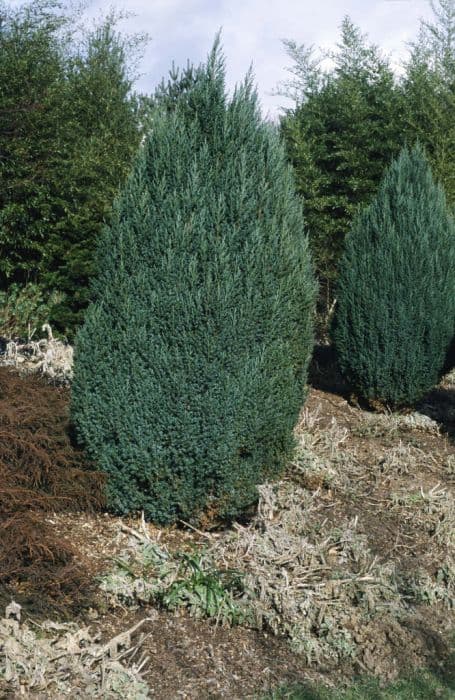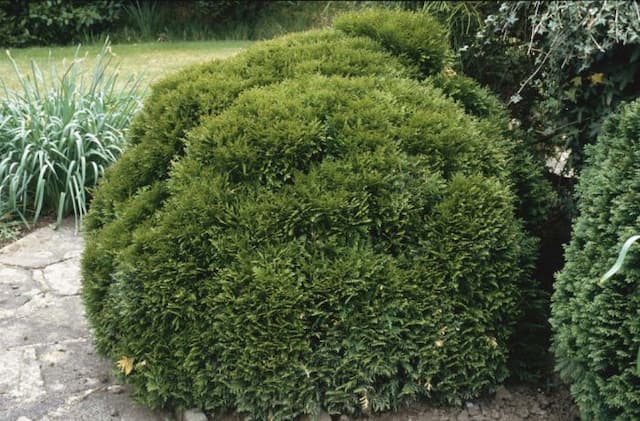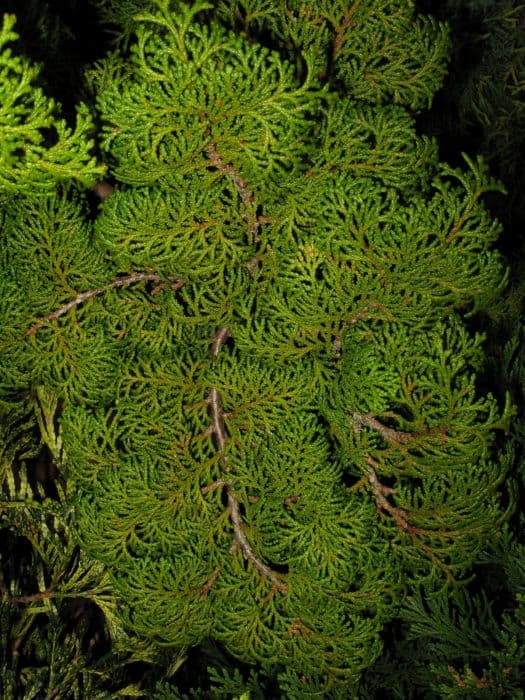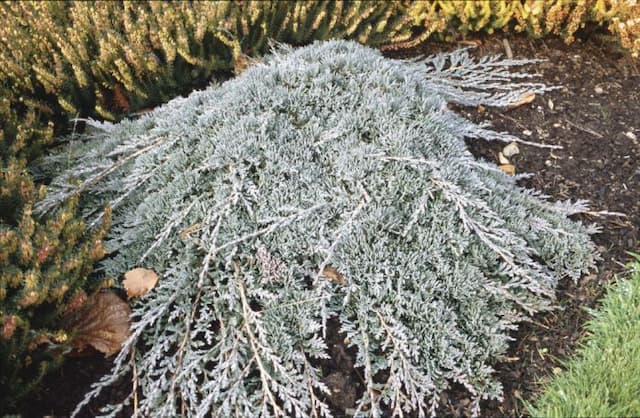Mediterranean Cypress Cupressus sempervirens

ABOUT
The plant commonly known as the Italian Cypress is characterized by its evergreen foliage with a dark green to blue-green color. The leaves are small and scale-like, and they are tightly arranged along slender, rounded twigs. This dense foliage grows in a very columnar or narrow-conical shape, giving the plant a very sleek and elegant profile. The Italian Cypress has a rigid, upright growth habit that creates a very formal and tidy silhouette without any pruning. The trees produce small cones that are somewhat rounded, about the size of a small walnut, with several scales that are tightly closed. These cones typically mature in two years, starting out green before turning brown. The bark of the Italian Cypress is also distinctive, with a fibrous texture and a color that can range from grey to a reddish-brown as it ages. The overall appearance of the plant is stately and refined, often associated with Mediterranean and classical landscapes due the tree's prevalence in those regions and its use in traditional garden design.
About this plant
 Names
NamesFamily
Cupressaceae
Synonyms
Mediterranean Cypress, Italian Cypress, Tuscan Cypress, Graveyard Cypress, Pencil Pine
Common names
Cupressus sempervirens var. horizontalis, Cupressus sempervirens var. fastigiata, Cupressus horizontalis, Cupressus pyramidalis, Cupressus fastigiata.
 Toxicity
ToxicityTo humans
The plant commonly known as the Italian Cypress is not highly toxic to humans. However, ingestion of parts of this plant, especially the seeds, can potentially cause gastrointestinal discomfort and symptoms such as nausea, vomiting, or diarrhea. In general, it is not considered severely toxic, but it is advisable to avoid consuming any part of this plant to prevent possible negative health effects.
To pets
Italian Cypress is generally not considered toxic to pets such as dogs and cats. There is limited information on its toxicity, but it is not commonly reported to cause severe poisoning in pets. However, as with any non-food plant, ingestion of large quantities could potentially lead to mild gastrointestinal upset in some animals. Pet owners should always monitor their animals and prevent them from eating ornamental plants to ensure their safety.
 Characteristics
CharacteristicsLife cycle
Perennials
Foliage type
Evergreen
Color of leaves
Dark Green
Height
40 feet 12.2 meters
Spread
10 feet 3 meters
Plant type
Tree
Hardiness zones
7
Native area
Mediterranean
Benefits
 General Benefits
General Benefits- Landscape aesthetics - Italian Cypress adds a unique vertical element to landscapes and gardens with its tall, narrow growth habit.
- Privacy screens - Due to its dense foliage, it is commonly used as a natural privacy screen to shield homes and gardens from view.
- Windbreaks - Its robust growth and thick branches are effective in protecting areas from strong winds.
- Erosion control - The root system helps stabilize the soil, making it useful for controlling erosion on slopes and banks.
- Architectural accent - Its distinctive shape complements a variety of architectural styles and is often used to frame entrances or line walkways.
- Shade provider - Larger specimens can offer shade in sunny landscapes, despite its narrow shape.
- Habitat support - Birds and other wildlife utilize the tree for nesting and shelter.
- Durable wood - Wood from Italian Cypress is strong and resistant to rot, making it valuable for carpentry and construction.
 Medical Properties
Medical Properties- Antiseptic: Essential oil from Cupressus sempervirens has been used for its antiseptic properties.
- Anti-inflammatory: The extracts of the plant may have anti-inflammatory effects, potentially beneficial for conditions such as arthritis.
- Astringent: The astringent nature of the plant’s products can be utilized for skin care to tighten the skin and reduce excessive oiliness.
- Diuretic: Traditional use suggests that it can promote the flow of urine, helping in the removal of excess body fluids.
- Antispasmodic: The essential oil is said to relieve muscular spasms and cramps.
- Hemostatic: Traditional applications include using it to stop bleeding from small cuts and wounds.
- Vasoconstrictor: It may have properties that cause blood vessels to constrict, possibly used for hemorrhoids.
- Sedative: There are claims of its sedative effects which might help in conditions like anxiety and insomnia.
 Air-purifying Qualities
Air-purifying QualitiesThis plant is not specifically known for air purifying qualities.
 Other Uses
Other Uses- Cupressus sempervirens, commonly known as the Mediterranean Cypress, can be used in furniture making due to its durable and aromatic wood that provides a natural moth repellent quality.
- The wood of the Mediterranean Cypress is valued for its resistance to decay and is often used in the construction of musical instruments for its acoustic properties.
- The tree's dense and columnar growth habit makes it ideal as a windbreak, especially in coastal areas subjected to strong winds.
- Mediterranean Cypress is used in landscape architecture for its formal appearance, often planted in rows to frame avenues or pathways.
- The cones of the Mediterranean Cypress are sometimes used in crafts and decorative arrangements, providing a natural and rustic element.
- Wood shavings and offcuts from Mediterranean Cypress are used as mulch in gardens to suppress weeds and retain soil moisture.
- In carpentry, the Mediterranean Cypress's wood is fashioned into veneers for paneling and ornamental purposes due to its fine grain.
- The essential oils derived from the foliage of Mediterranean Cypress are used in perfumery and aroma therapy for their fresh and woody scent.
- Mediterranean Cypress wood is carved to create sculptures and artistic pieces, showcasing its smooth texture and lustrous finish.
- The tree serves as an important habitat and food source for various wildlife species, including birds which nest in its dense foliage.
Interesting Facts
 Feng Shui
Feng ShuiThe Italian Cypress is not used in Feng Shui practice.
 Zodiac Sign Compitability
Zodiac Sign CompitabilityThe Italian Cypress is not used in astrology practice.
 Plant Symbolism
Plant Symbolism- Mortality: The Mediterranean Cypress, or Cupressus sempervirens, is often used in graveyards and has become a symbol of mourning and death due to its dark foliage and tall, columnar shape resembling a funeral spire.
- Eternity: Despite its association with death, the tree is also seen as a symbol of eternal life, as it is an evergreen and can live for hundreds of years.
- Resilience: The Mediterranean Cypress's ability to withstand harsh conditions and strong winds has made it a symbol of strength and endurance.
- Immortality: In ancient cultures, such as in Persia, the Cypress was considered a sacred tree and symbolized immortality due to its long lifespan and evergreen nature.
 Water
WaterThe Italian Cypress should be watered regularly during the first growing season to establish a deep, extensive root system. Once established, they are quite drought-tolerant and require less frequent watering. During the dry months, deeply water mature trees every two to three weeks with about 15-20 gallons, depending on the size and age of the tree. Ensure that the soil is well-draining to prevent root rot. It's crucial to avoid overwatering the Italian Cypress, as they do not tolerate soggy soil conditions well.
 Light
LightItalian Cypress thrives in full sun conditions, which means at least 6 hours of direct sunlight per day. The best spot for this plant would be an area where it is exposed to unfiltered sunlight for most of the day. Avoid planting it in shade or heavily filtered light, as this can stunt growth and decrease the tree's vigor.
 Temperature
TemperatureItalian Cypress does well in a wide range of temperatures but thrives best in zones with mild winters and hot summers. They can survive minimum temperatures of around 10°F to 15°F and maximum temperatures well over 100°F. Ideally, this tree does well in temperatures between 40°F and 80°F. Their hardiness makes them suitable for many microclimates within temperate zones.
 Pruning
PruningPrune Italian Cypress to maintain its shape and remove any damaged or diseased branches. Pruning is best done in the late winter or early spring before new growth starts. The frequency of pruning depends on the desired shape and size; however, minimal pruning is typically required. The best time to do extensive pruning is when the tree is dormant. Always use clean, sharp tools to make precise cuts.
 Cleaning
CleaningNot needed
 Soil
SoilItalian Cypress requires well-draining soil with a slightly acidic to neutral pH of 6.0 to 7.5. A mix of loamy soil, peat, and sand is ideal to ensure proper drainage and root aeration. Nutrient-rich compost can be added to provide a balanced environment for healthy growth.
 Repotting
RepottingItalian Cypress trees, being slow-growing conifers, do not need frequent repotting. Young trees can be repotted once every two to three years, whereas mature trees can be left longer, depending on their growth rate and pot size.
 Humidity & Misting
Humidity & MistingItalian Cypress thrives in average humidity conditions typical of outdoor environments. Indoor grown trees should be kept in a well-ventilated area, not requiring high humidity levels.
 Suitable locations
Suitable locationsIndoor
Provide bright light, occasional watering, and well-draining soil for Italian Cypress.
Outdoor
Plant in full sun, well-draining soil, and water moderately for Italian Cypress.
Hardiness zone
7-11 USDA
 Life cycle
Life cycleCupressus sempervirens, commonly known as the Italian Cypress, begins its life cycle as a seed, usually released in abundance from cones that require the heat of a fire or hot summer temperatures to open and release their seeds. Upon germination, the seedling establishes itself with a primary root that delves into the soil while the shoot begins to grow upwards. As the Italian Cypress matures into a young tree, it develops a tall, slender form with a straight trunk and tightly packed branches, characterized by scaled leaves. During its reproductive stage, the tree produces both male and female cones, with the small male cones releasing pollen into the air and the larger female cones developing seeds over time. After pollination and seed maturation, the life cycle can begin anew as these seeds disperse, often aided by wind, birds, and other vectors. With a potential lifespan of hundreds of years, an Italian Cypress can go through this reproductive cycle many times, creating a long-lived population of trees within its native or cultivated habitat.
 Propogation
PropogationPropogation time
Spring-Early Summer
The Cupressus sempervirens, commonly known as the Italian Cypress, is typically propagated through seed or cuttings, with cuttings being the most popular method. To propagate Italian Cypress from cuttings, semi-hardwood cuttings are usually taken from the current year's growth in late summer. These cuttings should be about 6 to 8 inches long (15 to 20 cm) with the lower leaves removed. It is essential to dip the cut end in a rooting hormone before planting in a well-drained soil mix. The cutting should then be placed in a shaded area and kept moist until roots have developed, which can take several months. Once rooted, the new plant can be transplanted to its permanent location.









